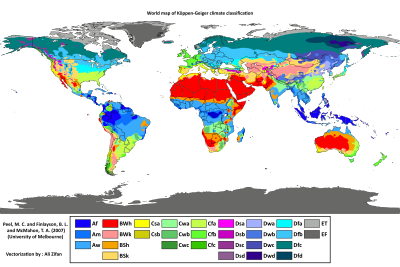Basic Geography/Climate/Global Climate
Appearance
Global Climate Zones
[edit | edit source]Different forests of the world experience different climatic conditions.
A forests climate influences the types of vegetation and animals that live there. It is therefore possible to divide the world into a number of climatic zones each with its own characteristic climate, vegetation and wildlife.
- Tropical forests are found near the equator in Central America, parts Africa and Asia. They are very hot and humid and contain a huge variety of plants and animals - round half of all the world's species. Trees are mostly hardwood.
- Temperate deciduous forests contain trees that lose their leaves and are found across Europe and USA.
- Coniferous forests contain pine trees are found further north than deciduous forests, in Scandinavia, Russia and Canada.
- Desert is the driest of areas. The largest expanse of desert is found in North Africa. Areas of scrubland that border the desert are called desert scrub.
- Savannas or tropical grasslands are hot and dry, dominated by grass, scrub and occasional trees. They have two distinct seasons - a dry season when much of the vegetation dies back, and a rainy season when it grows rapidly. Savannas are found in central Africa (Kenya, Zambia, Tanzania), northern Australia and central South America (Venezuela and Brazil).
- Temperate grasslands are areas dominated by grass, where trees and large bushes are scarce. The weather is less harsh than the savannas. Famous grasslands include the Puszta in Hungary, Veldts in South Africa, Pampas in Argentina, and Prairies in USA.
- Mediterranean is a pleasant climate - not too hot or cold. As the name suggests it is found around the Mediterranean Sea and to a lesser extent elsewhere.
- Tundra surrounds the poles. It has an extremely cold climate, with limited numbers of plants and animals.
- Mountain areas can be very cold at night and during winter. The growing season is short and at higher levels trees will not grow.

Climate Types
[edit | edit source]The above climatic zones can be grouped into the following types:
- Tropical
- Monsoon
- Dry
- Warm
- Cool
- Cold
One of the easiest ways to tell these zones apart is to look at the climatic graph - a graph showing the average rainfall (usually shown as a bar graph) and average temperature (usually shown as a line graph) for each month in an average year.
Tropical
[edit | edit source]
- Generally winds are light, but occasionally tropical winds can be very powerful.
- The tropics lie between the latitudes of the Tropic of Cancer (23°26'22" North of the Equator) and the Tropic of Capricorn (23°26'22" South of the Equator). However tropical climates are also experienced by some regions outside the tropics.
Monsoon
[edit | edit source]- Monsoons occur in tropical and sub-tropical regions of the world.
- There are two distinct seasons dry and wet.
- The climate in South-East Asia, India and across the Indian Ocean is dominated by torrential monsoon rains. Monsoons also affect parts of Africa and South America.
- The savannas regions of the world, the most extensive of which are in Africa, also have very pronounced wet and dry seasons. The only difference to the main monsoon areas is that the dry season is longer and the wet season shorter.
Dry
[edit | edit source]
- In the dry climatic zone there is little rain - sometimes no rainfall at all. This produces desert or semi-desert regions.
- Desert skies are characterized by bright clear sunny skies, with no sign of cloud formation.
- Deserts are found on every continent except Europe.
- Deserts will spread into neighboring areas of grassland or bush. This may be caused by the climate, perhaps due to lack of rainfall, but it can also be helped along by man, through overgrazing and cultivation. This process is called desertification.
Warm
[edit | edit source]- The warm climate regions are found north and south of the equator, midway between the areas that have a rainy season and the areas that have a cool climate. They lie in Europe, North America and Asia in the northern hemisphere and parts of Australia, South America and the southern tip of Africa in the southern hemisphere.
- The seasons are of similar lengths. The temperatures are comfortable - not too cold in the winter, not too hot in the summer.
- The precipitation (usually rain) is well-balanced, with slightly more rain during the winter months than the summer months, but no rainy season. In the hottest months, local winds help keep the temperature cool.
Cool
[edit | edit source]- This climate covers the northern parts of Europe and America, extending from the warmer climate in the south to the very cold climate of the polar region above.
- The cool climate zone includes the coniferous forests and parts of the temperate grasslands.
- The winter season will tend to be longer than the summer season, and brings cool winds and regular night-time frosts.
Cold
[edit | edit source]
- The cold climate zone lies between the coniferous forests and the poles. It includes the Arctic and Antarctic as well as parts of Russia and Alaska.
- Hi be sub-tropical.
- There are few summer months. The mean temperature for the year is below 0°C and temperatures will not get higher than 10°C. The ground may remain frozen all year round.
- Precipitation (ice, snow, rain) is fairly low, but balanced throughout the year. Irregular strong winds blow across the barren landscape.
